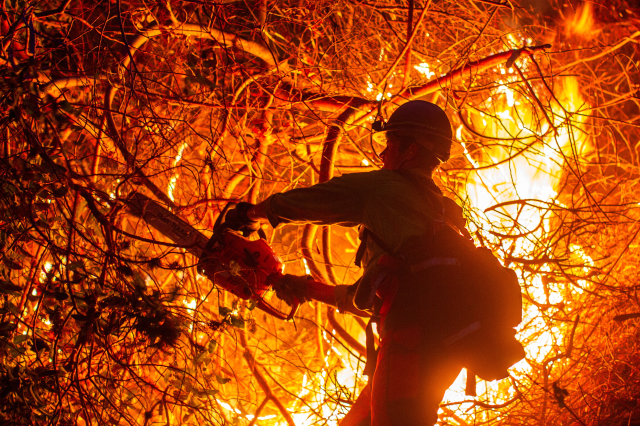 | Know better. Do better. |  | Climate. Change.News from the ground, in a warming world |
|
| | Year-round threatThe scale and ferocity of the wildfires that ripped through the Los Angeles area this past week were astonishing. Uncontrollable flames obliterated whole neighbourhoods and killed at least 24 people.
The fires have displaced tens of thousands of people and caused an estimated $150 billion of economic damage. And the flames are still spreading.
The fires are also a stark reminder of the immense fuel held in forests' vegetation, with reserves built up after a couple of wet winters, ready to be set alight and spread by a dangerous cocktail of drought and extreme wind.
Los Angeles is no stranger to wildfires. But the destruction has placed renewed focus on what the city and state should do to better manage forests.  A firefighter extinguishes the fire as the Palisades Fire burns in Mandeville Canyon, a neighborhood of Los Angeles, California, U.S., January
12, 2025. REUTERS/Ringo Chiu |
The disaster has also fed into the longstanding feud between California Gov. Gavin Newsom and President-elect Donald Trump, who has repeatedly said the state should do more to prevent fires by raking and cleaning up forest floors.
In response, the Governor's office has said the forest management budget increased tenfold - to $2 billion - since he took office.
Politics aside, our correspondent David Sherfinski heard from experts that more must be done across the country, especially as climate change increases the risks of more extreme weather.
"There's absolutely no question that more forest management is needed in the United States to make our forests resilient to wildfire," said Jad Daley, president and CEO of the non-profit American Forests. |
Fighting fire with fireManaging forest fires involves techniques like thinning vegetation and carrying out controlled burning - called prescribed fires - to reduce the flammable material available and slow the spread of any eventual blazes.
In Brazil, for example, our correspondent Andre Cabette Fabio followed Afro-descendent firefighters using these methods to tackle blazes in the Pantanal wetland.
Recognised for techniques that have been passed down several generations, these Kalunga firefighters were sent to Canada in 2023 to help the country deal with its major wildfires.  Kalunga firefighters from the Prevfogo brigade hold leaf blowers at the Pantanal wetland in Corumbá, Brazil, September, 11, 2024. Thomson Reuters Foundation/Henrique Kawaminami |
Once frowned upon by environmental officers, their prescribed fires in the wet
season have been shown to prevent wildfires when peak fire season hits.
There has been a similar reticence in the United States. Bad press followed accidents when prescribed fires spun out of control, while firefighting firms and non-profits are struggling to get insurance coverage to carry out the burns.
It is also a question of resources: the U.S. Forest Service reportedly halted prescribed burns in California toward the end of 2024 because firefighters were needed elsewhere.
Given the power of the LA wildfires, it is unlikely that forest management alone could have stopped the tragedy. But as the risks from wildfires continue to increase, authorities will have to use all the tools at their disposal.
See you next week,
Jack |
|
|
|